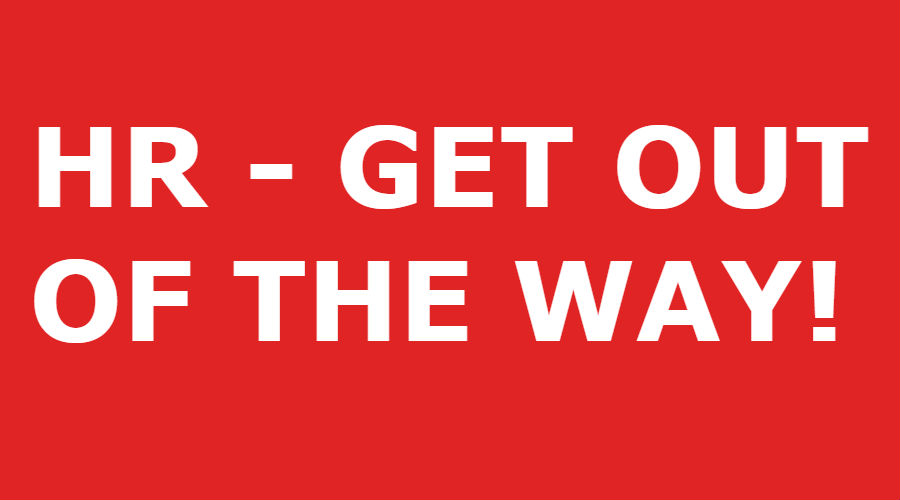
It’s the annual employee engagement survey! The data is in – now it’s time to act, right!?
Not usually the case. HR finally gets the data from a third party, organizes it in a way that will speak to each department, address leaders and managers about what the issues are specific to their teams, and then mandate programs to ensure the organization reacts to the engagement drivers that really need attention…
…in the three months it takes to do all this, the insights are less applicable and your employees feel like you just don’t listen. We’ve all heard of or lived through this story.

The Unnecessary Filter
There are many issues with the current process, from too expensive to what I like to call ‘time insensitive,’ but I think the biggest problem is that HR has become an unnecessary filter in companies. Sometimes HR just needs to get out of the way.
What’s the purpose of this information going directly to the HR department and then filtering the data and message to each department? The important voice of the employee needs to go directly to the source that has the biggest impact on employee engagement: the leaders and managers.
If HR spent less time communicating engagement results to departments and mandating initiatives to remedy poor engagement and more time creating a transparent and open environment that enables leaders to be successful, they will see a better employee experience and the engagement and retention that goes along with it.
And I am in no way saying there’s no place for HR. I love the HR function and what it must stand for.
More now than ever, HR can make a major impact to an organization’s success. I think it’s extremely important for the HR department to be thinking about and living and breathing the experience of employees to create an environment where they can succeed. Most understand that engaged employees have multiple benefits to the success of customers and the bottom line.

All Teams Aren’t Created Equal
As our companies move quicker than ever and the organizational chart gets flatter, more decisions are being made at the team level. When it comes to employee engagement, we must respond to the speed of the workplace and enable managers and leaders to be successful.
When engagement results or the voice of the employee is collected, it’s traditionally looked at as an individual company’s aggregated performance, or split up by department or office location. But when that is done, actions are too often taken at a broad level. It’s like the ‘spray and pray’ method of marketing where we communicate the same message to different personas – it doesn’t work. When you explain to the head of a specific department that the department had poor engagement ratings on engagement drivers such as career growth and recognition, that’s not reflective of every single leader. It’s only when you serve the insights to individual leaders that they become more informed and accountable.
Why Does This Work For Leaders?
Leadership is about understanding the needs of the team and making them successful. When HR can enable employees to do this, overall company engagement and performance improves. This approach works for leaders because:
- Feedback is key – not being a filter offers leaders feedback in real-time. That real-time two-way feedback is critical in improving engagement and relationships.
- It makes leaders accountable – whether they like it or not, having this feedback delivered to them and knowing that the data is public to the executive team builds accountability for them and how they run their teams. It’s a great constant reminder.
- It aligns leaders with their team – when done frequently, knowing the pulse of a team is key towards making decisions that help a team be successful.
Now ask yourself – do you have the right leaders for this type of feedback and responsibility? Deloitte published the 2017 Global Human Capital Trends and one major theme is that leadership will continue to be disrupted. “This new type of leader must understand how to build and lead teams; keep people connected and engaged; and drive a culture of innovation, learning, and continuous improvement.”
A major way that you can impact the results that matter to HR is to supply leaders with the right employee feedback to help connect them with the employees. Or, re-think how you hire and interact with managers and leaders.
But Does it Work For HR?
So why get more frequent pulses of engagement or offer feedback directly to leaders in the first place? Shouldn’t they be in tune already?
They should, but it’s also the responsibility of HR to understand which leaders are high-potentials that you can’t afford to lose and which leaders require training or actions that will prevent early exits and retention issues.
At the End of the Day…
…it’s all about creating an environment where employees (and leaders, remember they’re employees too!) can be successful. Amidst all these changes happening in our workforce HR needs to adjust their approach to enable leaders in their organizations to succeed. After all, leaders account for 70% of the variance in employee engagement scores and have the largest impact on engagement.
When it comes to responding to this changing workplace and enabling our leaders, ask yourself: are you in, or are you in the way?
